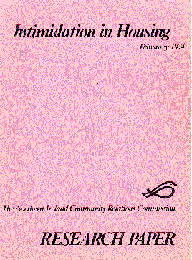
Intimidation in Housing
| ||||||||||||||||||||||||||||||||||||||||||||||||||||||||||||||||||||||||||||||||||||||||||||||||
| Foreword | ||
| SECTION A: | BACKGROUND | |
| Chapter 1 | Historical | |
| Chapter 2 | Methodology | |
| Chapter 3 | Review of Literature | |
| SECTION B : | INTIMIDATION - HOUSING | |
| Chapter 4 | Theory of Intimidation | |
| Chapter 5 | Family Case Studies | |
| Chapter 6 | Community Case Studies | |
| Chapter 7 | Movements in Belfast | |
| Chapter 8 | Movements outside Belfast | |
| Chapter 9 | General observations | |
| SECTION C | INTIMIDATION - CONSEQUENCES | |
| Chapter 10 | Squatting | |
| Chapter 11 | Effects on Mental Health, Education and Community Development | |
| SECTION D | THE AGENCIES | |
| Chapter 12 | The Role of the Agencies | |
| SECTION E | PROPOSALS | |
| Chapter 13 | Research Proposals | |
| Chapter 14 | Recommendations | |
| SUMMARY | ||
| Total movements August 1969 - February 1973 | ||
| Summary | ||
| Main points | ||
This report was prepared for the Commission by two of its officers, Mr John Darby and Mr Geoffrey Morris, to assist the Commission in considering the problems of intimidation and its effect on the community. The Report was completed in Spring 1973. It has since been sent to a number of involved agencies and voluntary bodies and their comments were invited. Corrections have been made where factual inaccuracies have been pointed out, and in one other case a quote from an agency has been included as an addendum.
It is not difficult for anyone who has come into contact with intimidation to appreciate some of the horrors which intimidated families undergo. What is not so generally known is the number of families which have suffered directly from intimidation and the effect which this has had on the social fabric of Northern Ireland. A total investigation of these issues would require much more time and resources than were available when the research for this report was carried out; no one is more conscious than the authors of its incompleteness. For example, it was not possible to examine satisfactorily the areas outside Greater Belfast, nor to look in detail at the effect of housing migration in many parts of the city itself, nor to conduct follow-up interviews with some of the victims whose cases were investigated. It should be stressed therefore that this report makes no claims to be definitive or comprehensive. Indeed the reason for including a chapter on research proposals was to indicate areas of investigation which had been revealed by this study.
The Commission hopes that the findings in the Report will not be used to score points in Northern Ireland's sectarian debate. It is sectarianism which allowed intimidation to grow and infect society, but the problem created by intimidation is a human one, involving ordinary people. It would be most unfortunate if people who have already suffered so much were to be used as political ammunition.
W B RANKIN
Chairman
February 1974
© 1974 N.I. Community Relations Commission
CAIN
contains information and source material on the conflict
and politics in Northern Ireland. CAIN is based within Ulster University. |
|
|
|||
|
Last modified :
|
||
|
| ||
